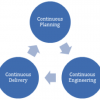release management
 |
Effective Release Management Starts with Stability Release management is an evolving process that needs continuous improvement, and there’s no such thing as a “perfect” release process. The best you can do is find one that works for your organization, which takes time, effort, and a willingness to evolve. However, teams can adopt a strategy that accelerates this trial-and-error period and helps deliver organizational consistency around a common goal: stability.
|
|
 |
Focus on Agile Engineering Methods in Your Digital Transformation Organizations undergoing a digital transformation must adopt new and meaningful ways of working. For a successful transformation, in addition to agile processes, teams must also leverage agile engineering techniques and models. Continuous focus on agile engineering principles will provide a solid ground for teams to enhance their agility and deliver better software, faster.
|
|
 |
Top 10 AgileConnection Articles of 2017 Agile software development is mainstream by now, but people are still finding ways to experiment with agile. Measuring agile success with metrics, the debate over whether to use estimates, and improving predictability in Scrum were all hot topics last year. The rise of DevOps has given even more material for people curious to adopt the practice, so automation and "continuous everything" were also popular subjects.
|
|
 |
Why DevOps Still Needs Release Management Release management is still critical in a DevOps environment. You likely will just have to change your current process. You will no longer need to track implementation or back-out plans as part of change orders; you just need to be able to track the application, its components, and its promotion schedule. The key to maintaining these change orders is automation.
|
|
 |
Reducing the Risk of Failed System Updates As software applications become more powerful and complex, users are demanding seamless and automatic updates. There is nothing worse than a “bricked system” after a failed update. The selection of a reliable file system is a vital component of the software update process.
|
|
 |
Do You Give Your Manager What She Wants or What She Needs? High-stress situations arise when you have to respond to management's never-ending tough questions regarding product delivery. According to Johanna Rothman, you can properly set expectations without stress simply by understanding your manager's point of view.
|
|
 |
Quick, Before We Release Matt Heusser presents ten key factors to establish a team cadence—the time between running tests and getting a product into production. The shorter the cadence, the less time spent in test/fix/retest land, and the more time spent working on new features.
|
|
|
|
Traditional Test Engineering, Your Days Are Numbered In the first installment of this article, Dr. James Whittaker discussed turning testing on its head—to revitalize and improve the value of late-stage testing. James also discussed ideas behind empowering your dogfooders, testers, and the crowd to significantly and efficiently improve software quality. In part two, Jason Arbon discusses the research and engineering experimentation behind realizing these ideas into new tools and processes.
|
|
 |
Giving Control Back to Software Developers: An Interview with Mike Faulise
Video
In this interview, Michael Faulise, the founder and managing partner at tap|QA, explains how the move toward DevOps and away from release management is giving control back to developers, then details why major companies often need partners to leverage CI, CD, and other modern techniques.
|
|
 |
Testing Early and Often: An Interview with Matthew Bissett In this interview, Matthew Bissett, the test manager responsible for the integration and testing of his area's flagship system for Her Majesty's Government, shares his thoughts with us on the importance of early testing in order to rapidly speed up software releases.
|
|
 |
Continuously Delivering Success: An Interview with Jesse Dowdle Jesse Dowdle sat down with us recently to discuss the benefits that embracing "massive" continuous integration and deployment brings to testing. Jesse is presenting the session "Massive Continuous Integration and Light Speed Iterations" at the 2012 Better Software Conference East.
|
|
 |
An Interview with Sanjiv Augustine: ADC-BSW 2013 Interview Series
Video
Committed to covering the latest trends and approaches for anyone investigating or implementing agile development practices, processes, technologies, and leadership principles, Agile Development & Better Software Conference West offers their 2013 interview series.
|
Sanjiv Augustine, LitheSpeed
|
 |
An Interview with Dawn Haynes: ADC-BSW 2013 Interview Series
Video
Committed to covering the latest trends and approaches for anyone investigating or implementing agile development practices, processes, technologies, and leadership principles, Agile Development & Better Software Conference West offers their 2013 interview series.
|
Dawn Haynes, PerfTestPlus Inc.
|
|
|
Reduce Release Cycle Time: Nine Months to a Week - Nice!
Slideshow
Picture this scene from three years ago: Employing the corporately mandated processes, a software engineering team is delivering system updates about once every nine months. When their senior user suddenly demands the next delivery in twenty-two weeks-half the current cycle duration-the team realize that they must quickly change development practices. Mathew Bissett describes how Her Majesty's Government did precisely that-and much, much more. First, they reduced delivery cycles from unpredictable dates every nine months to predictable releases every six weeks. Then, they cut releases cycle time to once every week. By identifying and mitigating risks early in the work intake process, enforcing quality gates, executing multiple test levels concurrently-and more-they dramatically increased throughput with the same or better quality. Today, these new processes provide their teams the best balance of structure versus agility.
|
Mathew Bissett, UK Government
|
 |
STARWEST 2012 Keynote: State-of-the-Art Cloud Testing: Experiences with Bing Search
Video
The cloud is penetrating every technology organization and almost every software product or service. The cloud affects everything inside development, bringing profound changes to how engineers build, test, release, and maintain software and systems.
|
Ken Johnston, Microsoft
|
Visit Our Other Communities
AgileConnection is a TechWell community.
Through conferences, training, consulting, and online resources, TechWell helps you develop and deliver great software every day.
